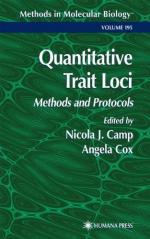|
This section contains 380 words (approx. 2 pages at 300 words per page) |
Quantitative traits are characteristics such as plant height or seed size, which can vary over a large range of possible values. The chromosomal regions controlling variation in a quantitative trait are known as quantitative trait loci.
The set of hereditary material transmitted from parent to offspring is known as the genome. It consists of molecules of deoxyribonucleic acid (DNA) arranged on chromosomes. Genetic markers are neutral DNA sequences that have no effect on an individual's physical appearance but are identifiable in the laboratory. Using statistical methods, the location of markers within an organism's genome can be estimated. The linear ordering of markers literally acts as a road map across the organism's genetic composition. This information allows a plant breeder to associate (link) an inherited observable characteristic such as seed size with a marker. This makes it possible to identify progeny possessing that characteristic (even before it shows) by determining whether the individual has that particular genetic marker. In plant breeding applications, the location of specific regions of a genome responsible for controlling quantitative variation of a trait, such as seed size, is of increasing concern to those interested in crop performance.
Quantitative traits may be affected by many loci. A statistical representation (mathematical equation) of the quantitative trait describes the genetic variation in each region of the genome. Quantitative trait loci (QTL) analysis provides information for selectively manipulating genetic components of a trait. The basis of QTL detection, regardless of the crop to which it is applied, is the identification of associations between genetically determined phenotypes (physical characteristics) and genetic markers (genetic characteristics).
The emergence of high-resolution molecular marker technologies is likely to facilitate large-scale QTL analyses. QTL studies provide a first step in understanding the genetics that underlie the expression of quantitative traits. The hope for future research is that the foundation and knowledge gained from QTL research will aid our understanding of the biological function of genes, thus continuing the long history between the fields of genetics and statistics.
See Also
Breeder; Breeding; Genetic Engineer; Molecular Plant Genetics.
Bibliography
Doerge, R. W., Zhao Bang Zeng, and Bruce S. Weir. "Statistical Issues in the Search for Genes Affecting Quantitative Traits in Experimental Populations." Statistical Science 12, no. 3 (1997): 195-219.
Thoday, J. M. "Location of Polygenes." Nature 191 (1961): 368-70.
|
This section contains 380 words (approx. 2 pages at 300 words per page) |


